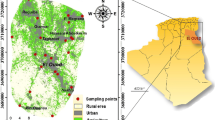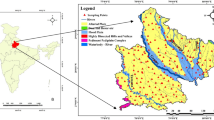Abstract
Rameswaram–Dhanushkodi coastal tract lies in the south–east of Rameswaram Island, which stretches about 20 km from the Rameswaram proper and occults several historic values. The objective of the present study is to investigate the water quality parameters viz., pH, electrical conductivity (EC), total dissolved solids (TDS), salinity (SAL), total alkalinity (TA), calcium hardness (CH), magnesium hardness (MH), total hardness (TH), chloride (Cl), and fluoride (F) during summer and winter seasons of the year 2006. The calculated Langelier Saturation Index values confirm the incrusting ability in most of the groundwater samples. The Water Quality Index values show that the potable quality of groundwater is improved from about 32% to 58%, especially in post-winter. The principal component analysis identifies the dominance of CH, TA, and TH with 33% and 44% in summer and winter, respectively. In addition, Cl is also having dominance in winter. The box plots have depicted asympathy in concentrations of F, TDS, and CH during winter, whereas sympathetic relationship in Cl and MH. Unlike in summer, a good correlation of Cl with the other parameters including SAL, EC, TDS, CH, and TH is observed in the winter.
Similar content being viewed by others
References
Anon (2005). To review the coastal regulation zone notification 1991. Ministry of Environment and Forests.
APHA (1998). Standard methods for the examination of water and wastewater. Washington D.C.: American Public Health Association.
Chow, V. T. (1964). Handbook of applied hydrology. New York: McGraw-Hill.
Department of Economics and Statistics (2006). Statistical hand book. Ramanathapuram: Department of Economics and Statistics.
Fetter, C. W. (1990). Applied hydrogeology. New Delhi: CBS.
Gupta, S., Banerjee, S., Saha, R., Datta, J. K., & Mondal, N. (2006). Fluoride geo-chemistry of groundwater in Nalhati-1 block of the Birbhum District, West Bengal, India. Fluoride, 39, 318–320.
Handa, B. K. (1995). Geochemistry and genesis of fluoride containing groundwaters in India. Ground Water, 13, 275–281. doi:10.1111/j.1745-6584.1975.tb03086.x.
Hem, J. D. (1967). Study and interpretation of the chemical characteristics of natural water (pp. 103–110). Washington DC: US Government Printing Office.
Jacobs, W. (1937). Preliminary report on a study of atmospheric chlorides. Monthly Weather Review, 65, 147. doi:10.1175/1520-0493(1937)65<147:PROASO>2.0.CO;2.
Kulasekaran, A., & Balakrishnan, P. (2002). Status of fluoride in groundwater in Tamil Nadu. Chennai: Tamil Nadu Water Administrative Department.
Langelier, W. F. (1946). Chemical equilibria in water treatment. Journal of American Water Works Association, 38, 169.
Levin, R. I., & Rubin, D. S. (2001). Statistics for management (p. 262). New Delhi: Prentice Hall of India.
Leung, C.-M., Jiao, J. J., Malpas, J., Chan, W.-T., & Wang, Y.-X. (2005). Factors affecting the groundwater chemistry in a highly urbanized coastal area in Hong Kong: An example from the middle-levels area. Environmental Geology, 48, 480–495.
Mahloch, J. L. (1974). Multivariate techniques for water. Quality analysis. Journal of the Environmental Engineering Division, Proceedings of the American Society of Civil Engineers (London), 100(No. EE5), 119–1132.
Mason, B. (1952). Principles of geochemistry. New York: Wiley.
Norusis, M. J. (1996). SPSS for windows.6,1,3. Users guide. Chicago: SPSS Inc.
Naik, D. P., Malini, U., & Somashekar, R. K. (2007). High fluoride content in groundwater—A case study in Bagepalli, Kolar District, Karnataka State. Ecology Environmental Conservation, 13, 303–305.
Sawyer, C. N., & McCarty, P. l. (1967). Chemistry for sanitary engineers, 2nd edn. New York: McGraw-Hill.
Tiwari, T. N., & Mishra, M. (1985). A preliminary assessment of water quality index of major Indian rivers. Indian Journal of Environmental Protection, 5, 276–279.
Valenznela-Vasquez, L., Ramirez-Hernandez, J., Reyes-Lopez, J., Sol-Uribe, A., & Lazaro-Mancilla, O. (2006). The origin of fluoride in groundwater supply to Hermosillo City, Sonora, Mexico. Environmental Geology, 51, 17–27. doi:10.1007/s00254-006-0300-7.
World Health Organisation (2004). Guidelines for Drinking Water Quality (vol. 2). Health Criteria and other supporting information (2nd edn, pp. 231–233). Geneva: WHO.
Author information
Authors and Affiliations
Corresponding author
Rights and permissions
About this article
Cite this article
Ramachandramoorthy, T., Sivasankar, V. & Subramanian, V. A seasonal quality assessment on potability of fresh shallow aquifers along the Rameswaram–Dhanushkodi coastal tract, India. Environ Monit Assess 159, 511–520 (2009). https://doi.org/10.1007/s10661-008-0647-1
Received:
Accepted:
Published:
Issue Date:
DOI: https://doi.org/10.1007/s10661-008-0647-1




